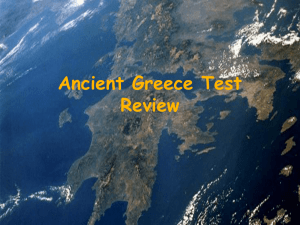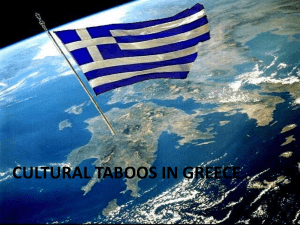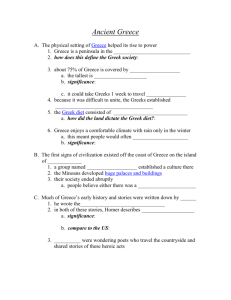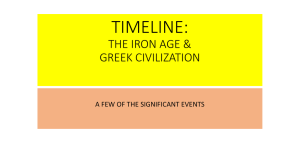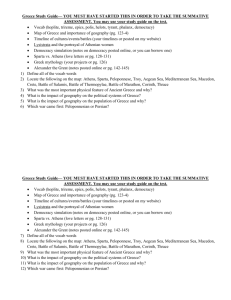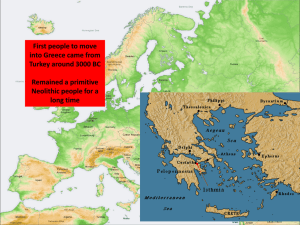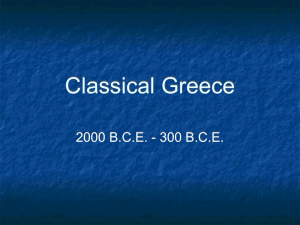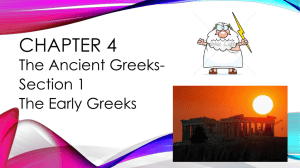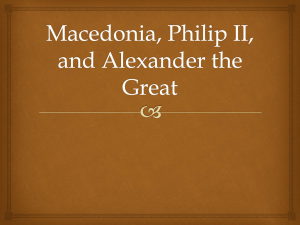Chapter 4 – Civilization of the Greeks powerpoint
advertisement
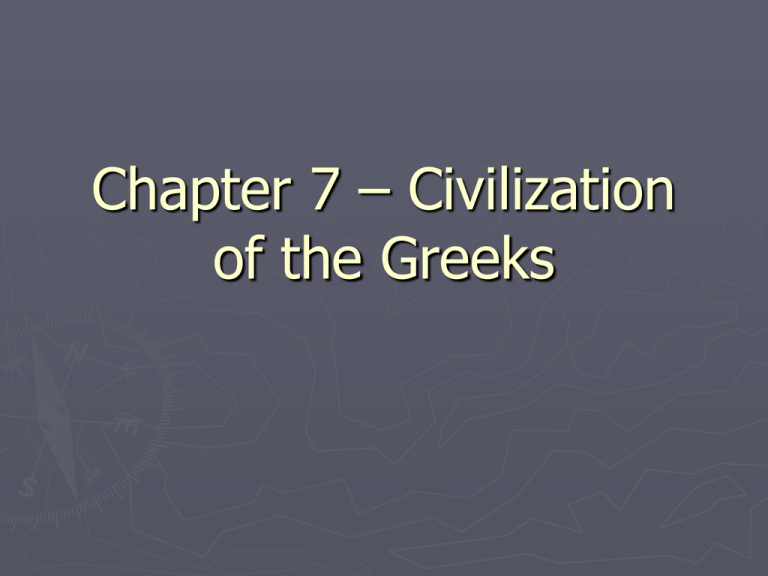
Chapter 7 – Civilization of the Greeks Geography played a major role in Greek History … Mountains – kept each community separated from each other – natural borders Seacoast – lots of inlets and bays – become a seafaring people Between 750 and 500 B.C.E., Greek civilization witnessed the emergence of the city-state as the central institution in Greek life and the Greeks’ colonization of the Mediterranean and Black Seas. Classical Greece lasted from about 500 to 338 B.C.E. and encompassed the high points of Greek civilization in arts, science, philosophy, and politics, as well as the Persian Wars and the Peloponnesian War. I. ► ► ► ► ► Minoan Crete 2800 BC - just off Greek mainland prosperous culture and sea empire traveled and traded with Egyptians reached its height in 2000-1450 BC Knossus (see map) Sudden collapse in 1450 BC – invasion of Mycenaeans II. Mycenaeans 1600-1100 BC (height of culture) Indo-European group powerful monarchs warrior people built extensive commercial network Story by Homer … King Agamemnon conquers Troy in 1250 BC The term Mycenaean is derived from Mycenae, a remarkable fortified site excavated by the amateur German archaeologist Heinrich Schliemann starting in 1870. Mycenae was one center in a Mycenaean Greek civilization that flourished between 1600 and 1100 B.C.E. The Mycenaean Greeks were part of the Indo-European family of peoples who spread from their original location into southern and have become shrouded in mystery. III. Dark Ages of Greece (1100-750 BC) Decline in Greek Population About 850 BC things start to improve … iron replaces bronze (affordable weapons for defense) Farming is revived adopted the Phoenician alphabet Homer appears to write myths and stories ► ► ► ► Ideas of excellence, virtue, heroism (Iliad and Odyssey) “Homer did not so much record history, but make it …” The Slaying of Hector This scene, painted on a Corinthian Greek vase, depicts the final battle between Achilles and the Trojan hero Hector, as recounted in Homer’s Iliad. The Iliad is Homer’s epic masterpiece and was used by later Greeks to teach the aristocratic values of courage and honor. © AAAC/Topham/The Image Works IV. The Greek City States 750 – 500 BC city-states begin to emerge Known as POLIS (Poleis) At center of City-states or polis was the AGORA or marketplace where the lower courts were held Polis community had 3 parts: 1. citizens with rights (adult males) 2. citizens with No rights (women & children) 3. non-citizens (slaves and resident aliens) Military system emerges: Hoplite Infantry – heavily armed with bronze or leather helmets, breastplates, shin guards, shields and swords – only those that could afford the weapons could be a part of this militia group Phalanx – formations that the hoplite infantry used to advance against enemy – rectangular shape Watch the 1st PBS Video on Greece (Link to videos through CPCC Library – right click to open hyperlink) http://media.nclive.org/ Go to World History Go to "The Greeks, Crucible of Civilization" Parts 1 & 2 This is approximately 1.5 hours of video. Please read through the next slides on the PowerPoint before watching the movie. This will help you take notes. This information will be included in your next quiz. Between 750 – 550 BC (Archaic Greece) a great number of Greeks left the colonies: 1. growing gulf between rich and poor 2. overpopulation 3. development of trade (increased industry) Tyrants appear as rulers (not Evil) – rulers Not subject to laws … young aristocrats (See page 160 for definition of tyrant) Tyrant Pisistrates ► Reduced taxes/free loans ► Offered people chance at prosperity (olives & industry) 527 BC Pisistrates dies … Hippias When brother is murdered turns against people … Cleisthenes overthrows Hippias with help from other aristocracy and crowds … (510 BC) Aysagarus joins with Spartans (rivals of Athenians) to exile Cleisthenes and other aristocracy … rules from Akropolis 508 BC ******* Revolution !!!!!!! Bring Cleisthenes back …. Democracy is born! http://media.nclive.org/ Go to World History Go to "The Greeks, Crucible of Civilization" Part 3 This is the 2nd PBS Video you need to view on Greece – Classical Greece. The PowerPoint frames that follow reflect what you will view. Part II – Classical Greece I. Age of Pericles – Height of Athenian Greek Power ► Assembly passed all laws and made final decisions on war and foreign policy Made lower-class citizens eligible for public office Olympic games Became leading center of Greek culture – Drama/theatre Classical idea of art – statues of gods Philosophy (“love of wisdom”) Sophists – scholarly realists Rhetoric – debate Socratic Method – question and answer techniques Herodotus – early Greek historian and master story teller ► ► ► ► ► ► ► ► ► Advancements were a threat to Sparta The Parthenon The arts in Classical Greece were designed to express the eternal ideals of reason, moderation, symmetry, balance, and harmony. In architecture, the most important form was the temple, and the classic example of this kind of architecture is the Parthenon, built between 447 and 432 B.C.E. Located on the Acropolis in Athens, the Parthenon was dedicated to Athena, the patron goddess of the city, but it also served as a shining example of the power and wealth of the Athenian empire. © Photodisc (Adam Crowley)/GettyImages II. Sparta grows out of Myacean empire – warriors “descendants of Zeus” ► ► ► ► Oligarchy – not a democracy 2 kings over military Gerousia – council of elders (shared power with kings) Apella – general assembly of all male citizens Very closed/strict society 500BC Sparta uses military might to gain control of Peloponnesus (dominates Peloponnesian League) Return to the Reading (Chapter 6 Persia) on page 149 – 150. Xerxes vowed to finish the job of his father and defeat Greece. Sparta in charge of “land war.” – King Leonidas Athens in charge of “sea war.” – Themistocles Sparta’s objective was to hold off the Persian army (Thermopylae – mountain pass in Greece) until the naval fleet was in place at Salamis, and this would then force the Persians to make a naval battle. ***Note to students about the movie, “300.” There are as many fictional representations in this movie as there are facts. I encourage those of you who are movie lovers to see if you can determine fact/fiction after completing this section on Greece. III. Peloponnesian War and Decline of Greek States After the wars with Persia, for about 40 years, Greece was really a divided country. Athens v. Sparta 431 BC War breaks out … Athens = Defensive – stay behind walls of Athens Sparta = Offensive 405 BC Athens naval fleet is defeated at Ageospotami Athens Surrendered to Sparta All of Greece is weakened by the wars …. IV. Rise of Macedonia and Alexander the Great (Also see reading in textbook under Chapter 6, pages 150 – 151) 359 BC – Phillip of Macedonia ► Built a country on diplomacy and strength New military and technology Phalanx Sarisa (pike) Crossbows Catapults 338 BC - Victory over Athens and Thebes (battle of Coronea) Creates Corinthian League Alexander the Great (after Phillip is murdered) ► ► ► ► Became Macedonian warrior at 14 years old Served as a General at 18 years old. Takes over for his father at 20 years of age Continues use of military/technology 334 BC – Battle against Persia (Also see textbook pages 150-151) Alexander the Great This marble head of Alexander the Great was made in the second or first century B.C.E. The long hair and tilt of his head reflect the description of Alexander in the literary sources of the time. Alexander claimed to be descended from Heracles, a Greek hero worshiped as a god, and when he proclaimed himself pharaoh of Egypt, he gained recognition as a living deity. It is reported that one statue, now lost, showed Alexander gazing at Zeus. At the base of the statue were the words ‘‘I place the earth under my sway; you, O Zeus, keep Olympus.’’ © British Museum, London/HIP/Art Resource, NY In just twelve years, Alexander the Great conquered vast territories. Dominating lands from west of the Nile to east of the Indus, he brought the Persian Empire, Egypt, and much of the Middle East under his control. TYRE (off shore island) - key strategic location ► causeway – land bridge to island ► siege towers Please watch this brief video: http://www.youtube.com/watch?v=h2y4_ixurE8 (link to video on Alexander and Tyre) (right click to open hyperlink) 332 BC – Battle of Issus – Meets Darius III and defeats 332 BC (late) – Syria, Palestine and Egypt were under his control EGYPT 331 BC No bloodshed Proclaimed himself the “liberator” They proclaimed him “son of Amon” and Pharaoh Alexandria is built (center of culture/science/learning) HELLENISM – “to make Greek” – Greek way of Life is spread Pergamum Athen’s greatness starts to dwindle in the face of the new Alexander cities Greatest – Egypt and Pergamum ► ► ► ► great terraces huge theatre temples at high places public buildings/gymnasiums/agora Trajan Temple at Pergamum Temple of Sarapus Pergamum Theatre at Pergamum 327 BC – Enters India Complaining among Troops Turns around to go Home …. 323 BC – Alexander Ill and Dies (32 years old) Leaders begin to fight for Empire Hellenistic Kingdoms: 1. Macedonia – Antigonid Dynasty (most powerful) 2. Syria and East – Selucids (largest) 3. West and Asia Minor – Pergamum 4. Egypt – Ptolomy (wealthiest and most influential) good coast/harbor 1st lighthouse constructed (300-400 feet tall) The World of the Hellenistic Kingdoms Sketch of Lighthouse constructed at Egypt (Thiersch) Economic/Social/Trade ► ► ► Commerce increased as new cities spring up along conquest routes Most important product – grain Women gain more independence Culture ► ► ► ► Promoted theatre Historical and biographical literature Buildings Statues/sculptures Science ► ► ► Heliocentric view Round earth Archimedes – geometry, spheres, cylinders, PI – invetor Philosophy Athens remains center for philosophy Epicurus ► Self-interest as motivating force Stoicism (How to find happiness) ► Live in harmony with will of gods ► Public service = good

